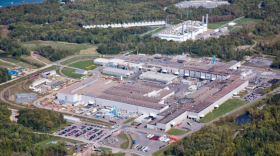A landmark agreement between the Onondaga Nation, New York state and the federal government returns more than 1,000 acres of forested land in southern Onondaga County back to the Onondaga. It’s one of the country's largest land transfers from a state government to an Indigenous people in history.
“There’s never been a parcel of land this size in New York, to my knowledge, that the state has transferred to an Indigenous nation,” said State DEC Commissioner Basil Seggos.
The 1,000 acre plot of land is mostly forested, but also includes some wetlands and a few waterfalls. It’s full of the creeks and waterways that are the headwaters of Onondaga Lake, once the sacred center of the Onondaga Nation that stretched over 2.5 million acres of central New York.
The Onondaga Nation ultimately became consigned to a reservation south of Syracuse, and the lake became one of the most polluted in the country, thanks to years of toxic waste dumped into the lake.

The land transfer has its roots in the cleanup of the lake, overseen by a superfund lawsuit by Honeywell, the company responsible for the pollution. The agreement also requires Honeywell to make amends for the losses caused by the pollution, called a natural resources damage assessment.
“It was a sacred lake, it had an incredibly abundant fish supply,” said Onondaga Nation attorney Joe Heath. “They have lost all of that, the cultural connection to the lake, the fishing. That’s part of the loss that’s supposed to be compensated in these natural resource damage assessment projects."
Nation representatives call this another step in healing between Indigenous people and others who live in the region and say they hope to restore and preserve these lands for future generations. Seggos hopes this also helps heal the divisive relationship that has existed between the state and Indigenous nations.
“We’ve had a sea change over the last year in how the state is prepared to cooperate and coordinate with Indigenous nations,” said Seggos. “Indigenous Nations across the state have a difficult history. We are trying to change that."
Heath said this is part of a national movement called land back, which seeks to heal and reclaim things connected with Indigenous groups.
"When we are looking at historical trauma for Indigenous people, land is the only reparation,” said Heath. “And this is part of that movement."
Seggos said this comes after a big change in the way the state works with Indigenous nations, which had been contentious in the past.
“I hope it’s an inspiration for us to think differently as we move into these kind of land transfers in the future,” he said. “And I hope it’s inspiration for other states as well and show what’s been done. We can achieve our environmental objectives. We can achieve our public access objectives, and we can right the wrongs of the past.”
Onondaga Nation member Jeanne Shenandoah said the land transfer was a lot of work, much of it was getting the state to understand the connection between nation members and the land.
"Most of our spiritual, cultural teaching to our people are to be appreciative and thankful for everything we have around us, and to live harmoniously on the land, to do things we are careful we are not exploiting of doing things to damage or destroy it,” said Shenandoah, who has spent time wandering the land in Tully that is part of her ancestral homeland. “It’s very, very beautiful there. There’s a beautiful waterfall, and it’s forest and some swamp and bogs, and a wonderful variety of plants living there.”
Under the agreement, the Onondaga will retain ownership of the land, but must allow public access to it and must keep it mostly in its current state.
“This historic agreement represents a unique opportunity to return traditional homelands back to Indigenous people to steward for the benefit of their community,” said Secretary of the Interior Deb Haaland in a statement. “We look forward to drawing upon the Onondaga Nation’s expertise and Indigenous knowledge in helping manage the area’s valuable wildlife and habitat. Consistent with the President’s America the Beautiful initiative, all of us have a role to play in this Administration’s work to ensure our conservation efforts are locally led and support communities’ health and well-being.”








